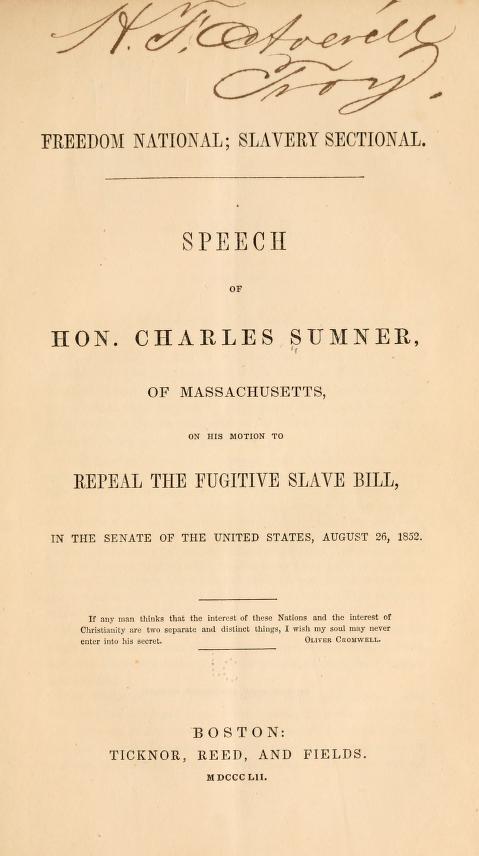NOTE FROM STEPHEN PULEO: I adapted this blog from my book, THE GREAT ABOLITIONIST: Charles Sumner and the Fight for a More Perfect Union because I thought it was important to highlight how Charles Sumner differed from other abolitionists. Sumner’s belief was that freedom and equality were America’s birthright, and racist laws were a perversion of those ideals. He saw the government’s tolerance and support for the growth of slavery in the 1840s and 1850s as an ignorant misreading of the country’s founding documents, not an inevitable condition flowing from them. As one of his congressional eulogists declared, Sumner “believed in his country, in her unity, her grandeur, her ideas, and her destiny.”
In the parlance of his day, U.S. Senator Charles Sumner of Massachusetts was considered a “Radical Republican.” But throughout his political life, in his battles against slavery and in favor of equal rights, Sumner makes a consistent conservative argument – that based on the country’s founding documents and the beliefs of its founders and framers, the default position of the United States should be freedom and equality.
He establishes his position during his first major speech in the Senate; literally the first major antislavery speech in U.S. Senate history. It was a four-hour masterpiece on August 26, 1852, against the Fugitive Slave Law, entitled Freedom National; Slavery Sectional, in which Sumner argued that slavery was a “deviant” sectional institution, while freedom was virtuous and national in scope.
Sumner set out to achieve a radical end – the destruction of the Fugitive Slave Law and perhaps the first step in the eradication of slavery itself – by employing conservative means. He put forth the case that supporters of the law, who most often saw themselves as conservative unionists, were actually “radical” sectionalists, while anti-slavery so-called “radicals” (like himself), portrayed as sectional agitators, were the true unionists.
He argued that the United States was born in an atmosphere of freedom for all men – it was only the “imbecility of Southern states” that had poisoned that atmosphere by condoning slavery – and that the notion of slavery as a national institution was anathema to the very precepts of the nation’s origins. With this approach, Sumner differed even from other prominent abolitionists, who often argued that slavery’s stain on the country’s founding was indelible.
Sumner demonstrated with ample evidence what he had been preaching for months prior – that a deep antislavery philosophy wove through the tapestry of the country’s founding and was incorporated within the Declaration of Independence (with its “all men are created equal” and “endowed with inalienable rights” clauses) and in several places within the Constitution. While compromise with the slave states was necessary to make possible the adoption of the Constitution – one reason the document did not explicitly prohibit slavery outright – its very ratification without mention of slavery was proof of the Founders’ intent to create a federal framework based on freedom, a system that defaulted to freedom (not slavery, as the South argued).
This point was most critical, Sumner argued. For slavery to be considered “national” in scope, it would require that the Constitution contain affirmative, unequivocal language that endorsed, sanctioned, or mandated it. Yet, in the same way the Constitution “contains no power to make a King,” it also contained “no power to make a slave or hunt a slave,” Sumner said. To find support for slavery in the Constitution was a fool’s errand because it simply did not exist, and no one could “infer, suppose, conjecture, surmise, fancy, guess, or presume that slavery can have any sanction in words which do not plainly and unequivocally declare it.”
Even the 1787 Northwest Ordinance, in which the Framers excluded slavery from all western territories then owned by the federal government, was another example of their devotion to liberty and hope for a slave-free future on the American continent.
All of this meant that Congress lacked authority to establish slavery within its purview, in the same way, Southerners argued it had no authority to impose laws in individual states to eliminate slavery. Here with decided brilliance, Sumner used the argument of slaveholders against them. The Fugitive Slave Law was the most egregious example, a “monstrous act” of the national government’s overreach. If the Constitution provided no protection for slavery in any federal jurisdiction – and he had made the case that it did not – it most certainly did not allow authorities from slave states, in the form of slave-hunters, to “stretch their arms” into free states and mandate the return of runaway slaves.
When Sumner took his seat, amid tumultuous applause from spectators who had given him their unbroken attention throughout the long speech, many in the citizens’ gallery – men and women alike – were reduced to tears.
Sumner lost the 1852 vote to repeal the Fugitive Slave Law in a most humiliating fashion – by a vote of 47-4. But for the first time ever, antislavery fire and brimstone rained upon the U.S. Senate in the heart of the nation’s capital. Sumner had, in a more thorough and effective way than anyone had ever before, set down the intellectual underpinnings that proved America’s founding tradition had its roots in antislavery dogma; and had credibly argued that the Constitution’s omission of slavery left no legal avenue for the federal government to support it, condone it, accept it, or mandate it.
In so doing, Sumner established the foundation for the antislavery and equal rights views he would articulate in the years to come in his nearly quarter-century fight to form a more perfect union.
###

